|
|

|
Porsche, and the Porsche crest are registered trademarks of Dr. Ing. h.c. F. Porsche AG.
This site is not affiliated with Porsche in any way. Its only purpose is to provide an online forum for car enthusiasts. All other trademarks are property of their respective owners. |
|
|
  |
| Spoke |
 Dec 31 2015, 08:43 AM Dec 31 2015, 08:43 AM
Post
#1
|
|
Jerry      Group: Members Posts: 7,295 Joined: 29-October 04 From: Allentown, PA Member No.: 3,031 Region Association: None 
|
This thread is meant to help those implementing LED turnsignals on their 914.
Standard flasher relays were designed to flash 2 standard bulbs (21W each) for turnsignals or 4 standard bulbs with 4-ways on. LED replacements burn between 2W and 5W and electrically may not behave at all like a standard bulb. The LED replacements can cause all kinds of weird things like hyperflash (2x normal flash rate), dash indicators do not work, or the the flasher relay does nothing at all. The 914 flasher is different for early cars 70-73 than later 74+ mainly because of the tach indicators. Early cars have individual L and R indicators and the 74+ have a single L+R indicator. Both are handled differently by the flasher. There are LED-compatible flashers generally available at your FLAPS which are plug-in but not totally function compatible with the 914 standard flasher. The functional issue revolves around the 4th terminal which the 914 uses to activate the dash indicators. The aftermarket flasher relays are EP26 (4 terminal) and EP36 (3 terminal). I've seen these at Pep Boys, Autozone, and Advance Auto to name a few FLAPS, usually for less than $15. I'll detail the differences between early and late cars, as well as EP26 and EP36 in the next few posts. |
| falcor75 |
 Dec 31 2015, 09:03 AM Dec 31 2015, 09:03 AM
Post
#2
|
|
Senior Member    Group: Members Posts: 1,579 Joined: 22-November 12 From: Sweden Member No.: 15,176 Region Association: Scandinavia 
|
Are you still making your led lights Spoke? I'd be interested on some.
|
| jmill |
 Dec 31 2015, 09:56 AM Dec 31 2015, 09:56 AM
Post
#3
|
|
Green Hornet     Group: Members Posts: 2,449 Joined: 9-May 08 From: Racine, Wisconsin Member No.: 9,038 Region Association: Upper MidWest |
Are you still making your led lights Spoke? I'd be interested on some. http://www.914world.com/bbs2/index.php?showtopic=272839 |
| Chris H. |
 Dec 31 2015, 10:00 AM Dec 31 2015, 10:00 AM
Post
#4
|
|
Senior Member     Group: Members Posts: 4,070 Joined: 2-January 03 From: Chicago 'burbs Member No.: 73 Region Association: Upper MidWest 
|
Could you cover converting the single indicator to the dual L/R as well if it's not too much trouble? I have an aftermarket tach now in my '75 car and it has a L and R indicator on it.
|
| Spoke |
 Dec 31 2015, 10:25 AM Dec 31 2015, 10:25 AM
Post
#5
|
|
Jerry      Group: Members Posts: 7,295 Joined: 29-October 04 From: Allentown, PA Member No.: 3,031 Region Association: None 
|
'70-'73 914 with separate L and R dash indicators. This arrangement is pretty straightforward and likely can work with the standard 914 flasher relay with a modification of the dash indicator common wire.
Below is a generalized schematic of the turnsignal system. Look at the flasher relay in the top right corner. It has 4 terminals: 49: This is power into the relay 49a: This is output to the turnsignal bulbs 31: Ground K: This pin drives the common wire to the the dash indicators. The flasher has dual purpose. It flashes the turnsignals and if the MC warning switch or E-brake switch is closed, will flash the brake warning dash indicator. Notice the K lead on the flasher goes through a second relay contact. The K lead is only active if a large current flows through 49a. This way it is active if turnsignals are being driven (like 40W or so) and inactive if a light load like the brake warning light is driving 49a. I will say here that connection of the K lead in the flasher below may not be correct. It may connect the K to ground. If someone has an extra flasher relay with the K lead and it works, I would gladly purchase it from you so I can test it. This flasher does not hyperflash as it is designed to flash normally for turnsignals (heavy load) and brake warning light (light load). The K lead is the one which causes problems. In general, over the years the second relay weakens such that it stops driving K and when either turnsignal is on, both flash at 1/2 brightness. When LEDs replace the standard exterior turnsignal bulbs, the lower current of the LEDs may not pull in the second relay and K will not drive the dash indicators. The solution to the K lead is to remove the common connection at the dash indicators and replace the wiring with a small Y pigtail like below. The removed common connection should be taped up so it doesn't contact anything. The K lead is not used at all. If the standard flasher works, there is no need to change it. If it doesn't work correctly with LED turnsignals, it can be replaced by the EP36. EP36 has 49, 49a, and 31 terminals and is plug-in compatible. 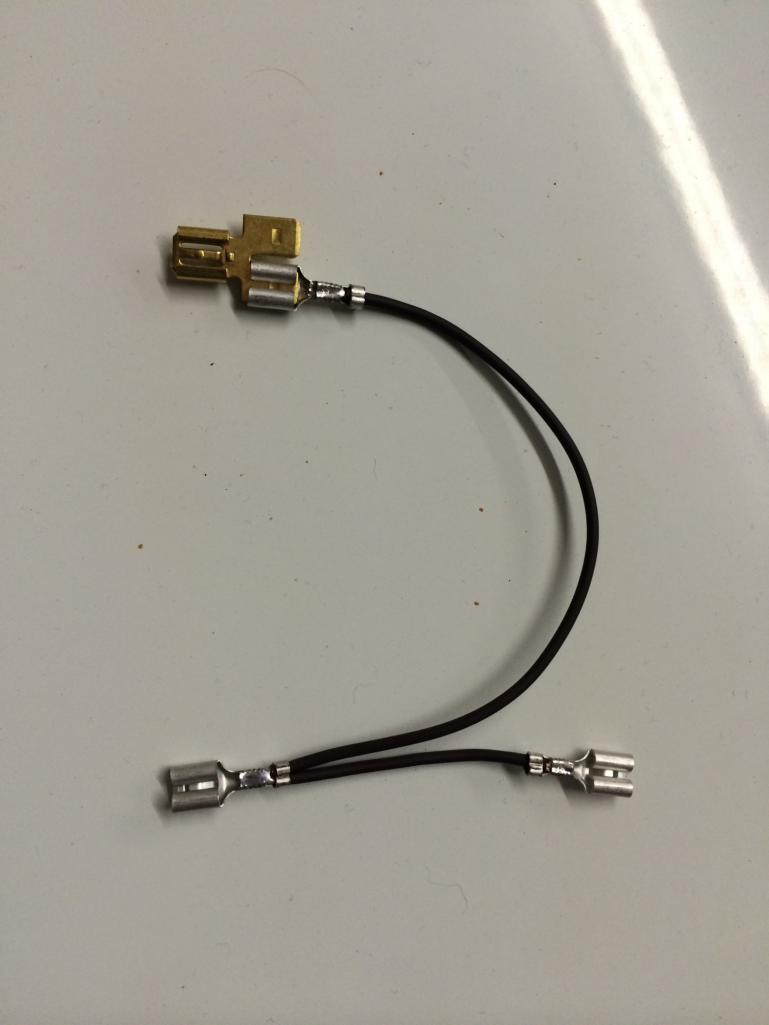 This pigtail connects both dash indicators to ground thus not using the K lead at all. 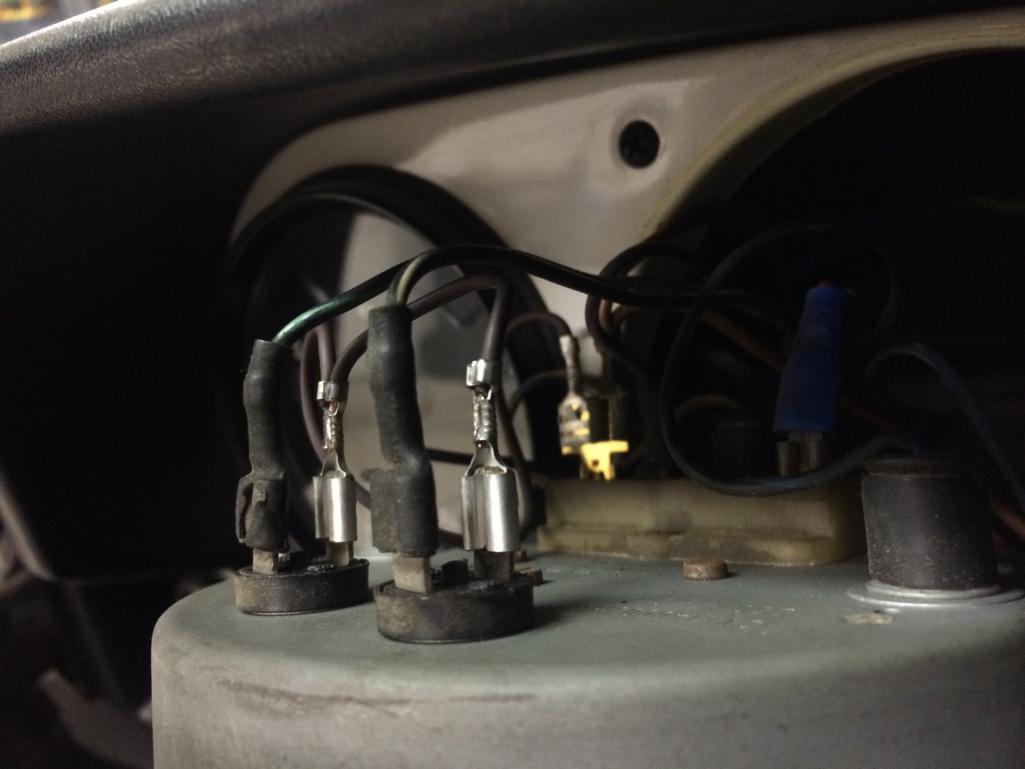 Ground lead sharing the ground (brown wire) of the tach. I have been including a 1:2 spade with turnsignal boards for a while. You would have to source the Y cable yourself. 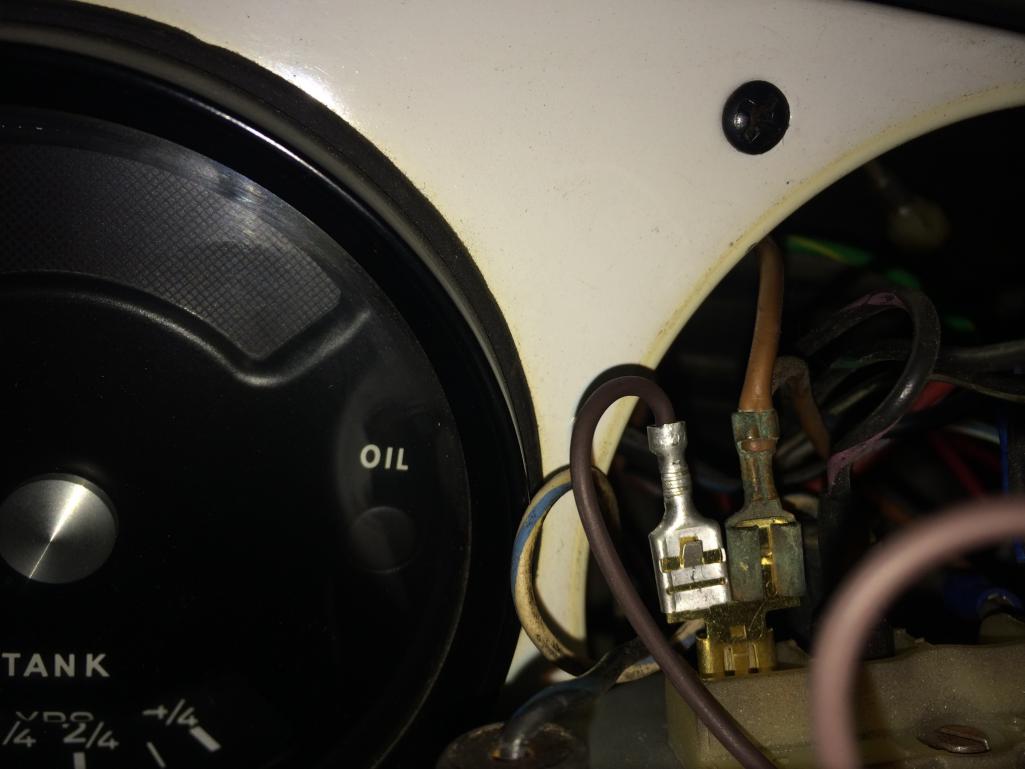 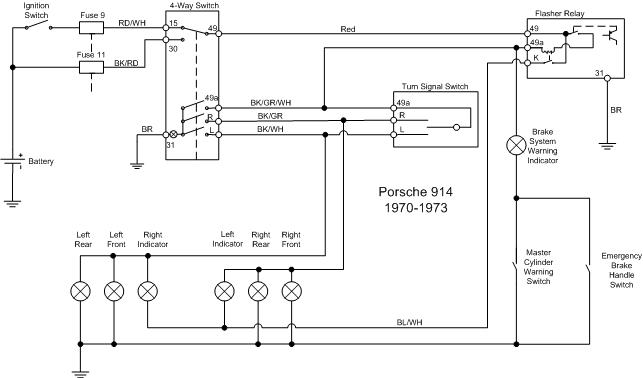 |
| Spoke |
 Dec 31 2015, 10:33 AM Dec 31 2015, 10:33 AM
Post
#6
|
|
Jerry      Group: Members Posts: 7,295 Joined: 29-October 04 From: Allentown, PA Member No.: 3,031 Region Association: None 
|
Could you cover converting the single indicator to the dual L/R as well if it's not too much trouble? I have an aftermarket tach now in my '75 car and it has a L and R indicator on it. Yes. This is the most troublesome setup because of the single indicator. If you have a tach with L and R indicators, it is easy to connect. Simply connect one end of the indicators to ground and the other to the turnsignal wires. These wires can be found easiest on the back of the hazard switch. |
| 913B |
 Dec 31 2015, 09:35 PM Dec 31 2015, 09:35 PM
Post
#7
|
|
Senior Member    Group: Members Posts: 863 Joined: 25-April 05 From: South Bay/SoCal Member No.: 3,983 Region Association: None |
'70-'73 914 with separate L and R dash indicators. This arrangement is pretty straightforward and likely can work with the standard 914 flasher relay with a modification of the dash indicator common wire. Below is a generalized schematic of the turnsignal system. Look at the flasher relay in the top right corner. It has 4 terminals: 49: This is power into the relay 49a: This is output to the turnsignal bulbs 31: Ground K: This pin drives the common wire to the the dash indicators. The flasher has dual purpose. It flashes the turnsignals and if the MC warning switch or E-brake switch is closed, will flash the brake warning dash indicator. Notice the K lead on the flasher goes through a second relay contact. The K lead is only active if a large current flows through 49a. This way it is active if turnsignals are being driven (like 40W or so) and inactive if a light load like the brake warning light is driving 49a. I will say here that connection of the K lead in the flasher below may not be correct. It may connect the K to ground. If someone has an extra flasher relay with the K lead and it works, I would gladly purchase it from you so I can test it. This flasher does not hyperflash as it is designed to flash normally for turnsignals (heavy load) and brake warning light (light load). The K lead is the one which causes problems. In general, over the years the second relay weakens such that it stops driving K and when either turnsignal is on, both flash at 1/2 brightness. When LEDs replace the standard exterior turnsignal bulbs, the lower current of the LEDs may not pull in the second relay and K will not drive the dash indicators. The solution to the K lead is to remove the common connection at the dash indicators and replace the wiring with a small Y pigtail like below. The removed common connection should be taped up so it doesn't contact anything. The K lead is not used at all. If the standard flasher works, there is no need to change it. If it doesn't work correctly with LED turnsignals, it can be replaced by the EP36. EP36 has 49, 49a, and 31 terminals and is plug-in compatible. This pigtail connects both dash indicators to ground thus not using the K lead at all. Ground lead sharing the ground (brown wire) of the tach. I have been including a 1:2 spade with turnsignal boards for a while. You would have to source the Y cable yourself. I have a spare early flasher relay I can donate to your research. I am not sure if it is working though or is there a problem with my car. My individual turn indicators would intermittently not flash or flash then stop pre maturely. I am ready to find a EP36 and try to get my indicators working. If you still want the relay PM me with your address and I can ship it to you. Ted |
| Spoke |
 Jan 1 2016, 05:33 PM Jan 1 2016, 05:33 PM
Post
#8
|
|
Jerry      Group: Members Posts: 7,295 Joined: 29-October 04 From: Allentown, PA Member No.: 3,031 Region Association: None 
|
I have a spare early flasher relay I can donate to your research. I am not sure if it is working though or is there a problem with my car. My individual turn indicators would intermittently not flash or flash then stop pre maturely. I am ready to find a EP36 and try to get my indicators working. If you still want the relay PM me with your address and I can ship it to you. Ted Thanks, PM sent for the flasher. About your flasher, the issue you describe is characteristic of the second relay losing efficiency. This can easily be corrected by rewiring the dash indicators as described earlier in this thread. As long as the flasher still flashes the exterior lights it is ok to use. EP36 does not have the 4th "K" terminal. EP26 does have it but the ones I've looked at the terminal is connected to nothing. I rewired one of the EP26's I had and gave it to a 914world member whose flasher wasn't flashing the dash indicator. |
| Spoke |
 Jan 1 2016, 06:33 PM Jan 1 2016, 06:33 PM
Post
#9
|
|
Jerry      Group: Members Posts: 7,295 Joined: 29-October 04 From: Allentown, PA Member No.: 3,031 Region Association: None 
|
'74+ 914 with single L/R dash indicator.
This flasher is an issue when changing to LED turnsignals. Notice the schematic below where the 4th terminal on the flasher relay is called C or C2. The C/C2 terminal is energized again with a second relay. The relay will pull in only when the heavy current of at least 2 turnsignal bulbs (front and rear) and flash the L/R indicator. When the brake warning light is on, the bulb passes very low current and will not pull in the second relay and will not flash the L/R dash indicator. When changing to LED turnsignals, the current from the turnsignals is now very low compared to the standard bulbs. Thus the second relay will not pull in and the L/R dash indicator will not flash with the turnsignals. There is no easy solution to fix this. The EP26 is pin-compatible but the small sample of EP26's I've looked, the C/C2 terminal was not connected to anything. There are a couple of solutions although neither are simple. The first solution is to change tach bodies from late tach to early tach. I did this in my '74 but I did it to get the separate L and R indicators. I really don't like the single L/R indicator. I swapped out the tach guts so all I used was the tach body. Another solution is to take the EP26 apart and wire the C/C2 to power the terminal when the relay flashes. The downside of this approach is the single L/R dash indicator will flash even when the brake warning light is active. Another solution is to power the single dash indicator from the L and R turnsignal wires. 2 diodes would be needed to isolate the L and R turnsignals from each other. The standard flasher can be used in this case. So for this configuration, there is no easy, simple answer. Any ideas on solutions would be greatly appreciated. 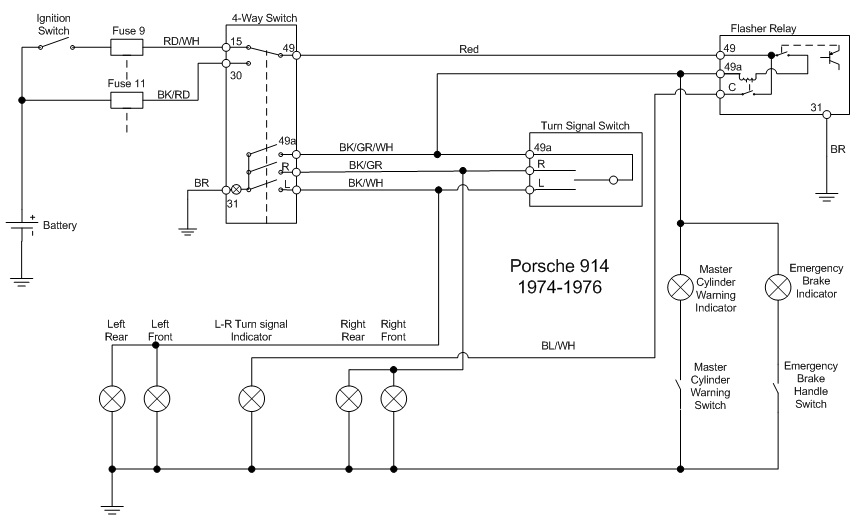 |
| peteyd |
 Aug 2 2018, 07:41 PM Aug 2 2018, 07:41 PM
Post
#10
|
|
Senior Member    Group: Members Posts: 740 Joined: 27-March 08 From: Elora, Ontario, Canada Member No.: 8,858 Region Association: Canada |
Awesome!
Giving credit where credit is due, this helped me out big time Spoke! Cheers, Pete |
| Mark Henry |
 Aug 12 2018, 04:16 PM Aug 12 2018, 04:16 PM
Post
#11
|
|
that's what I do!                Group: Members Posts: 20,065 Joined: 27-December 02 From: Port Hope, Ontario Member No.: 26 Region Association: Canada |
Very cool, I made my own flasher for my 67 bug. It's quite complex because the one 9-pin flasher controls turn, emergency and high/low beam lights. It was complex, I'd have to check my notes but IIRC I had to wire three DPDT relays together to duplicate the function of the one OE flasher.
I did the project because the flasher is scarce (NOS$200-$300) and the $80 re pops are known to be junk. |
| Spoke |
 Aug 14 2018, 09:57 PM Aug 14 2018, 09:57 PM
Post
#12
|
|
Jerry      Group: Members Posts: 7,295 Joined: 29-October 04 From: Allentown, PA Member No.: 3,031 Region Association: None 
|
Continuing the discussion of the early 914 ('70-'73) with separate left and right turnsignal indicators in the dash, many owners have noticed that the turnsignal indicators sometimes flash together with the OEM flasher. The simplified diagrams below show what is happening.
The diagrams show the flasher when the right turnsignal is selected and the lights are flashing ON. The K lead relay contact is closed when the high turnsignal current with standard bulbs flow through the main contact. In the left diagram, the secondary relay contact on the K lead is closed and current flows through the RIGHT turnsignal indicator and through the LEFT turnsignal bulbs. In this case the right indicator bulb is much lower wattage and higher resistance than the exterior high power standard bulbs and thus drops almost all the battery voltage and lights up. The small indicator current does not light up the left side exterior bulbs. I'm not sure why it's connected like this but there it is. In the right diagram, the secondary relay coil for the K relay has weakened over time and lost its efficiency. Now the K relay may close for the first flash or two then totally gives up and remains open like shown. What happens then is the current flows from the 49a turnsignal pin through both left and right indicators and through the left exterior turnsignal bulbs. Both left and right indicators light at a diminished intensity. The only solutions to this are replacing the flasher with an OEM or EP26 flasher, or disconnecting the center connection to the K lead and grounding the common connection as detailed above. EP26 needs modified internally to short the K/C2 lead to ground. I do this to EP26 flashers that I sell. 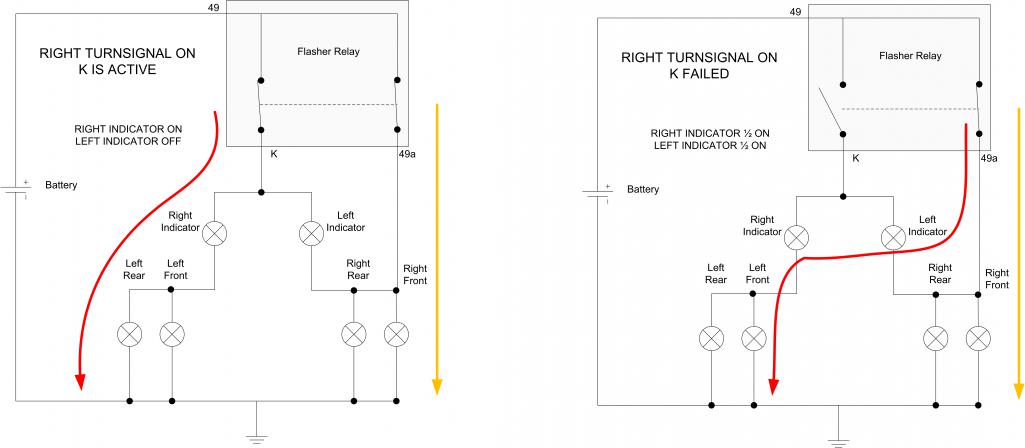 |
| Spoke |
 Aug 14 2018, 10:17 PM Aug 14 2018, 10:17 PM
Post
#13
|
|
Jerry      Group: Members Posts: 7,295 Joined: 29-October 04 From: Allentown, PA Member No.: 3,031 Region Association: None 
|
When LED turnsignals are installed, funny things happen when the OEM flasher remains in the vehicle. Installing a modified EP26 LED-compatible flasher alleviates these issues but requires the left and right turnsignal indicators in the tach to be swapped.
The left side diagram shows the case with an OEM flasher and LED turnsignals. For the OEM flasher, like the case with standard turnsignal bulbs and the K relay coil weakened and non-functional, with high impedance LED turnsignals, the K relay coil does not activate when flashing and stays open. Now the left and right turnsignal indicators are driven by the 49a lead through the left side LED turnsignals. But where the standard bulbs are very low impedance, high power bulbs, the LED turnsignals present a high impedance and thus a much lower power load. This causes the LED turnsignals to share the voltage with the turnsignal indicators and the indicators light gently and so do the LED turnsignals light gently. Several owners have seen this happen when changing to LED turnsignals. This ghosting of the opposite side turnsignals may not happen if only the front or rear turnsignal is LED and the other a standard bulb. When the OEM flasher is replaced by a modified EP26 flasher (K/C2 connected internally to ground) as shown in the right diagram, most turnsignal indicator issues are solved. Now the center connection of the indicators is connected to ground through the K/C2 pin. When the RIGHT turnsignal is flashing, the LEFT turnsignal indicator flashes. This opposite connection has been debated in other threads even if it exists at all although experience has shown this to be the case. After changing to LED turnsignals and EP26 flasher, many 914 owners have noticed the wrong indicator flashing after the conversion. The simple fix for this wrong indicator flashing issue is to pull the tach out, then pull the indicator bulbs and their sockets and swap the entire fixtures. The wires could be pulled off of each indicator and swapped but this may lead to broken wires. It's much easier to pull the entire socket and bulb and just swap them. 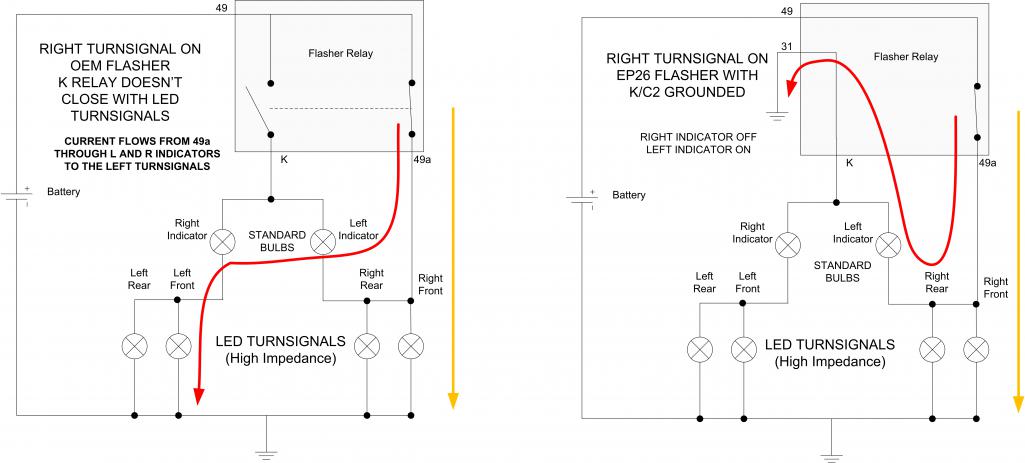 |
| VaccaRabite |
 Aug 16 2018, 07:32 AM Aug 16 2018, 07:32 AM
Post
#14
|
|
En Garde!           Group: Admin Posts: 13,829 Joined: 15-December 03 From: Dallastown, PA Member No.: 1,435 Region Association: MidAtlantic Region 
|
I wish I had seen this earlier. Now that I've been driving the car with the LEDs at all 4 corners, my dash indicator has just given me the finger and refuses to do its thing. I figured this was just something I'd have to live with (along with occasionally realizing that my turn signal had been on for the past mile or so)
I need to add this to the list of projects done on the car this winter. Zach |
| ClayPerrine |
 Aug 16 2018, 01:03 PM Aug 16 2018, 01:03 PM
Post
#15
|
|
Life's been good to me so far.....                Group: Admin Posts: 16,526 Joined: 11-September 03 From: Hurst, TX. Member No.: 1,143 Region Association: NineFourteenerVille 
|
When LED turnsignals are installed, funny things happen when the OEM flasher remains in the vehicle. Installing a modified EP26 LED-compatible flasher alleviates these issues but requires the left and right turnsignal indicators in the tach to be swapped. The left side diagram shows the case with an OEM flasher and LED turnsignals. For the OEM flasher, like the case with standard turnsignal bulbs and the K relay coil weakened and non-functional, with high impedance LED turnsignals, the K relay coil does not activate when flashing and stays open. Now the left and right turnsignal indicators are driven by the 49a lead through the left side LED turnsignals. But where the standard bulbs are very low impedance, high power bulbs, the LED turnsignals present a high impedance and thus a much lower power load. This causes the LED turnsignals to share the voltage with the turnsignal indicators and the indicators light gently and so do the LED turnsignals light gently. Several owners have seen this happen when changing to LED turnsignals. This ghosting of the opposite side turnsignals may not happen if only the front or rear turnsignal is LED and the other a standard bulb. When the OEM flasher is replaced by a modified EP26 flasher (K/C2 connected internally to ground) as shown in the right diagram, most turnsignal indicator issues are solved. Now the center connection of the indicators is connected to ground through the K/C2 pin. When the RIGHT turnsignal is flashing, the LEFT turnsignal indicator flashes. This opposite connection has been debated in other threads even if it exists at all although experience has shown this to be the case. After changing to LED turnsignals and EP26 flasher, many 914 owners have noticed the wrong indicator flashing after the conversion. The simple fix for this wrong indicator flashing issue is to pull the tach out, then pull the indicator bulbs and their sockets and swap the entire fixtures. The wires could be pulled off of each indicator and swapped but this may lead to broken wires. It's much easier to pull the entire socket and bulb and just swap them.  I put a set of LED bulbs into Elwood, and used an EP26 flasher. That made the turn signal bulbs act weird. So I removed the two connection bulb sockets from the back of the tach, and replaced them with single connection bulbs that ground through the tach. The wires that go back to the flasher are just disconnected. Now the turn indicators work fine. From your diagram, your modified flasher does basically the same thing. |
| worn |
 Aug 16 2018, 02:49 PM Aug 16 2018, 02:49 PM
Post
#16
|
|
Winner of the Utah Twisted Joint Award     Group: Members Posts: 3,522 Joined: 3-June 11 From: Madison, WI Member No.: 13,152 Region Association: Upper MidWest 
|
I wish I had seen this earlier. Now that I've been driving the car with the LEDs at all 4 corners, my dash indicator has just given me the finger and refuses to do its thing. I figured this was just something I'd have to live with (along with occasionally realizing that my turn signal had been on for the past mile or so) I need to add this to the list of projects done on the car this winter. Zach Another thing I learned when making a triple gauge is that if you replace the brake warning light with a low wattage LED the relay gets confused and the brake warning light flickers with or without the brake or master cylinder signal. Never realized that the stock relay monitors current. |
| worn |
 Aug 16 2018, 02:53 PM Aug 16 2018, 02:53 PM
Post
#17
|
|
Winner of the Utah Twisted Joint Award     Group: Members Posts: 3,522 Joined: 3-June 11 From: Madison, WI Member No.: 13,152 Region Association: Upper MidWest 
|
Nominate as a classic. LEDs may not be a flash in the pan, and could be with us awhile.
|
| tmc914 |
 Aug 16 2018, 05:41 PM Aug 16 2018, 05:41 PM
Post
#18
|
|
Member   Group: Members Posts: 116 Joined: 24-September 17 From: Lowell, MA Member No.: 21,452 Region Association: North East States 
|
This is helpful. Changed the lamp for the m/c dash indicator and with e-brake on both turn signal dash indicators flash crazy. Ordered a modified EP26 relay from Spoke and will see what that does to help. If it does not fix the problem then I'll put a higher wattage lamp in the dash indicator.
|
| 914werke |
 Aug 16 2018, 08:58 PM Aug 16 2018, 08:58 PM
Post
#19
|
|
"I got blisters on me fingers"           Group: Members Posts: 11,501 Joined: 22-March 03 From: USofA Member No.: 453 Region Association: Pacific Northwest 
|
So is this applicable to the late Tach with combined turn signal indicator?
|
| Spoke |
 Aug 16 2018, 09:39 PM Aug 16 2018, 09:39 PM
Post
#20
|
|
Jerry      Group: Members Posts: 7,295 Joined: 29-October 04 From: Allentown, PA Member No.: 3,031 Region Association: None 
|
So is this applicable to the late Tach with combined turn signal indicator? The EP26 LED-compatible flasher does not drive the C2 pin which powers the single L<>R indicator in the late tachs. C2 not being connected to anything is why I re-sell the EP26 flashers. I modify the C2 pin to connect to 12V when flashing for the late tachs. For the early tachs, C2 is shorted to ground (pin 31). |
  |
1 User(s) are reading this topic (1 Guests and 0 Anonymous Users)
0 Members:

|
Lo-Fi Version | Time is now: 29th December 2025 - 09:33 PM |
Invision Power Board
v9.1.4 © 2025 IPS, Inc.









